Kirby Larson's Blog, page 43
November 9, 2012
Friend Friday
I know he is a liar and a thief, but I dare you not to take Will Sparrow into your heart! Sold off by his father for a few mugs of ale, Will does his best to keep fit and fed. But when hunger trumps his better judgment, he must take to the road. And not the high road; not in the least. A warning to the faint of heart: much thievery and lying abounds in said tale. Our Will is not a very good thief, however, and he is soon at the mercy of road warriors much cagier than he.

Eventually, Will finds his way to a group of "fair folk" and to family. But what a family, including a cat girl and a dwarf very handy with his fists.
Will Sparrow's Road is Karen Cushman's first male main character and she nails it. Kirkus calls it "a compelling coming-of-age road trip," but it is much more than that. It is a feisty look at what it takes to find a place to belong.
Of course you will want to add this to your library, and of course, you will purchase it from your local independent bookstore!


Eventually, Will finds his way to a group of "fair folk" and to family. But what a family, including a cat girl and a dwarf very handy with his fists.
Will Sparrow's Road is Karen Cushman's first male main character and she nails it. Kirkus calls it "a compelling coming-of-age road trip," but it is much more than that. It is a feisty look at what it takes to find a place to belong.
Of course you will want to add this to your library, and of course, you will purchase it from your local independent bookstore!
Published on November 09, 2012 07:30
November 8, 2012
Thursday's Thought
The secret of getting ahead is getting started.
Sally Berger
Sally Berger
Published on November 08, 2012 07:30
November 6, 2012
Teacher Tuesday
Had I known that answering an email from Michele Meyer would result in my performing the Ohio State University fight song in front of the student body of Botkins Local School, I might have hesitated before hitting reply. But then I would have been deprived of a delightful connection with a small school with a huge heart!
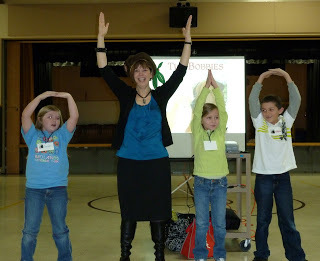 O-H-I-O!
O-H-I-O!
Michele and I connected over Hattie Big Sky . . .and kept connecting. It was one of the highlights of my professional life to meet her in person and spend the day at her school, a day, I might add, that began with my seeing my name up in lights! Okay. Not lights. But I was up there on the reader board at the local gas station and that is a pretty big deal.
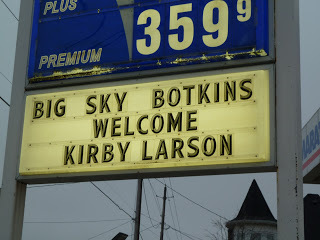
Michele is a reading specialist, working with student in grades K-6; she says, "working with all grade levels and skill levels makes my day fly by quickly!" Botkins Local School is a small rural school in West Central Ohio which prides itself on a long-standing history of academic success. Trust me: Michele could give the Energizer Bunny a run for the money, so you might need a triple shot of something caffeinated before reading today's interview!
First, let's take a peek at Michele's past!
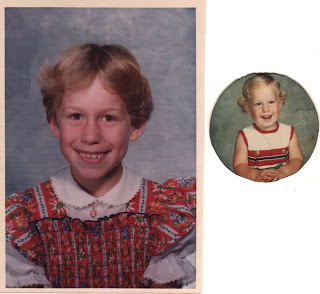 Second grade (L) Pre-K (R): Already wearing OSU red!
Second grade (L) Pre-K (R): Already wearing OSU red!
When our class presents our book-end activities, we always invite the other reading groups to participate (a.k.a. learn and have fun!). Because many of our book-end activities are open to the other students in the class who are not in our reading group, I consider these activities “advertisements” or “trailers” for the book our class has read. There is no better book recommendation than one from a fellow classmate and pal. Check! Another goal met…inspire others to read more.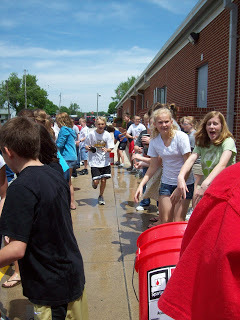 Bucket brigade to save the burning barn!
Bucket brigade to save the burning barn!
What kinds of books lend themselves best to extensions? Feel free to share titles of books that your kids have especially connected to.
Books that have rich vocabulary, figurative language and dynamic characters are the kind of books that lend themselves best to extension activities. Some of my favorites are Where the Red Fern Grows, The Westing Game, The Beef Princess of Practical County and, of course, Hattie Big Sky.
Teachers are notoriously resourceful – how do you come up with all of your creative ideas for book-related activities?
I am a begger, a borrower and a stealer! I have many great friends who are incredible teachers who share their cutting-edge work and ideas with me. If they give me something I like, I may tweak it and make it my own.
Magazines are another favorite resource of mine. Websites like Scholastic, International Reading Association and Google are my best resource friends. My crazy imagination takes off sometimes and all I need is a little spark of an idea to run wild with it. I jokingly call myself the “Connection Queen”.
Also, we often brainstorm as a class when it comes to forming ideal book-end activities. Here’s how it works: one student comes up with a good idea; two other students toss out additional tweaks to that good idea to make it great; and three others add their twist to that great idea. VOILA! A marvelously entertaining and educational activity has been born. Teamwork works!
Talk about some other ways you use literature to supplement the curriculum.
Literature can supplement the curriculum in countless ways. One of my favorite ways is through word walls. We create a life-sized vocabulary wall for many books we read that hold new vocabulary words from the book we are reading. Words from A-Z (with an additional area for important numbers) pack our hallways. Students use words from the wall to write summaries, create descriptions and analyze characters or settings.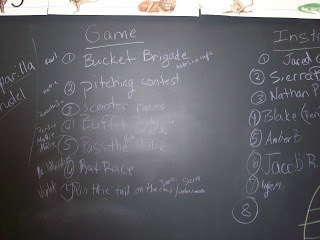 Word Wall
Word Wall
Thanks to the literature we have read, our class has learned about everything from the ins and outs of the stock market to customs of other cultures to how to show a steer! We have learned about historical events such as homesteading and the Holocaust as well.
Give us a few examples of activities, like Hats off to Hattie Day, that have grown out of your connections, please.
Our class has planned a Where the Red Fern Grows party where everything is centered around the theme of nature, hunting, country living, determination, loyalty and pursuing a dream.
Another fun day has been Westing Game Direction Day. This day is structured similarly to our Hats off to Hattie Day. Students are responsible for creating different whole class/team activities that demonstrate a specific character’s quirks, talents, interests, occupation or disposition.
Why do you think these literature extensions are important? What do students gain from them?
Literature extensions are vitally important if you want books to come to life and if you want students to have a memorable experience with those stories. The more students can relate and create, the better they are and the more they learn.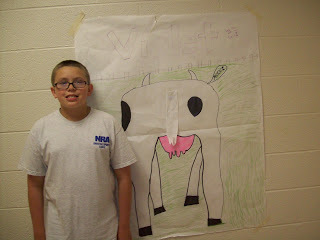 Pin Violet's tail back on!
Pin Violet's tail back on!
It makes me smile to think students are able to use a talent to convey their understanding of a scene, character or event from a story. It is amazing to see the students work collectively to come up with educational and fun activities, costuming and even refreshments.
Do you find your students suggesting titles/activities?
As I mentioned earlier, our brainstorming sessions in class are intensely spirited and a bit hard to keep up with on occasion! However, they are extremely productive. All ideas are welcome and encouraged. However, only those ideas that are well-developed and proven fun activities are approved for the activity day. I work with a creative crew of fun-loving kids. They require little of me to create an interactive, entertaining and education afternoon of book fun.
What has surprised you about these book end activities? Perhaps a specific student reaction, for example.
A very soft-spoken student surprised me by going all out and transforming himself into the “Ultimate Rooster Jim” character from Hattie Big Sky. The student even went to his barn and had a picture taken of him reading alongside his chickens as part of his project! Now that is proof he studied this character and knew the good, bad and smelliness of him.
 Trying parsley for the first time!
Trying parsley for the first time!
How does your administration support you in these activities?
Our administration is supportive of our students extending their thinking and being creative in demonstrating their academic growth. Often times, our principal and superintendent stop in to participate in some of the activity day fun.
Your students’ families?
We’ve had a mother voluntarily send in homemade strudel (a Hattie Big Sky staple) with her son for our class! Need I say more? We have also had a grandmother provide authentic shorthand notes from her schooling as a secretary when we were learning more about secretarial duties and the art of shorthand (Thank you Ms. Sydelle Pulaski, Secretary Extraordinaire, from the Westing Game for inspiring this activity).
Your community? We have taken a virtual tour around our small town trying to equate Billy Coleman’s adventure (in Where the Red Fern Grows) of going into town to pick up his pups from the train depot to what he’d see and where he’d go if he were to arrive in Botkins, Ohio.
What do you wish I had asked you about this book-related activities that I didn’t? Any last words/thoughts?
Believe it or not, I think you have left me speechless which doesn’t happen often. Great questions!
The only one thing I wish you would have asked me was the affect of connecting with an author (via email, SKYPE, in person, etc.) on a student! I could go on for pages about that. Kids still walk into my room and talk about your visit. Amazing…just plain, awesome and amazing.
I think this interview gives you a good idea of why Michele's reading room is a favorite school gathering spot. I so admire and appreciate Michele -- and all her educational colleagues! -- working so hard and creatively to ensure that students love learning. It does my heart good!
 O-H-I-O!
O-H-I-O!Michele and I connected over Hattie Big Sky . . .and kept connecting. It was one of the highlights of my professional life to meet her in person and spend the day at her school, a day, I might add, that began with my seeing my name up in lights! Okay. Not lights. But I was up there on the reader board at the local gas station and that is a pretty big deal.

Michele is a reading specialist, working with student in grades K-6; she says, "working with all grade levels and skill levels makes my day fly by quickly!" Botkins Local School is a small rural school in West Central Ohio which prides itself on a long-standing history of academic success. Trust me: Michele could give the Energizer Bunny a run for the money, so you might need a triple shot of something caffeinated before reading today's interview!
First, let's take a peek at Michele's past!
 Second grade (L) Pre-K (R): Already wearing OSU red!
Second grade (L) Pre-K (R): Already wearing OSU red!When our class presents our book-end activities, we always invite the other reading groups to participate (a.k.a. learn and have fun!). Because many of our book-end activities are open to the other students in the class who are not in our reading group, I consider these activities “advertisements” or “trailers” for the book our class has read. There is no better book recommendation than one from a fellow classmate and pal. Check! Another goal met…inspire others to read more.
 Bucket brigade to save the burning barn!
Bucket brigade to save the burning barn!What kinds of books lend themselves best to extensions? Feel free to share titles of books that your kids have especially connected to.
Books that have rich vocabulary, figurative language and dynamic characters are the kind of books that lend themselves best to extension activities. Some of my favorites are Where the Red Fern Grows, The Westing Game, The Beef Princess of Practical County and, of course, Hattie Big Sky.
Teachers are notoriously resourceful – how do you come up with all of your creative ideas for book-related activities?
I am a begger, a borrower and a stealer! I have many great friends who are incredible teachers who share their cutting-edge work and ideas with me. If they give me something I like, I may tweak it and make it my own.
Magazines are another favorite resource of mine. Websites like Scholastic, International Reading Association and Google are my best resource friends. My crazy imagination takes off sometimes and all I need is a little spark of an idea to run wild with it. I jokingly call myself the “Connection Queen”.
Also, we often brainstorm as a class when it comes to forming ideal book-end activities. Here’s how it works: one student comes up with a good idea; two other students toss out additional tweaks to that good idea to make it great; and three others add their twist to that great idea. VOILA! A marvelously entertaining and educational activity has been born. Teamwork works!
Talk about some other ways you use literature to supplement the curriculum.
Literature can supplement the curriculum in countless ways. One of my favorite ways is through word walls. We create a life-sized vocabulary wall for many books we read that hold new vocabulary words from the book we are reading. Words from A-Z (with an additional area for important numbers) pack our hallways. Students use words from the wall to write summaries, create descriptions and analyze characters or settings.
 Word Wall
Word WallThanks to the literature we have read, our class has learned about everything from the ins and outs of the stock market to customs of other cultures to how to show a steer! We have learned about historical events such as homesteading and the Holocaust as well.
Give us a few examples of activities, like Hats off to Hattie Day, that have grown out of your connections, please.
Our class has planned a Where the Red Fern Grows party where everything is centered around the theme of nature, hunting, country living, determination, loyalty and pursuing a dream.
Another fun day has been Westing Game Direction Day. This day is structured similarly to our Hats off to Hattie Day. Students are responsible for creating different whole class/team activities that demonstrate a specific character’s quirks, talents, interests, occupation or disposition.
Why do you think these literature extensions are important? What do students gain from them?
Literature extensions are vitally important if you want books to come to life and if you want students to have a memorable experience with those stories. The more students can relate and create, the better they are and the more they learn.
 Pin Violet's tail back on!
Pin Violet's tail back on!It makes me smile to think students are able to use a talent to convey their understanding of a scene, character or event from a story. It is amazing to see the students work collectively to come up with educational and fun activities, costuming and even refreshments.
Do you find your students suggesting titles/activities?
As I mentioned earlier, our brainstorming sessions in class are intensely spirited and a bit hard to keep up with on occasion! However, they are extremely productive. All ideas are welcome and encouraged. However, only those ideas that are well-developed and proven fun activities are approved for the activity day. I work with a creative crew of fun-loving kids. They require little of me to create an interactive, entertaining and education afternoon of book fun.
What has surprised you about these book end activities? Perhaps a specific student reaction, for example.
A very soft-spoken student surprised me by going all out and transforming himself into the “Ultimate Rooster Jim” character from Hattie Big Sky. The student even went to his barn and had a picture taken of him reading alongside his chickens as part of his project! Now that is proof he studied this character and knew the good, bad and smelliness of him.
 Trying parsley for the first time!
Trying parsley for the first time!How does your administration support you in these activities?
Our administration is supportive of our students extending their thinking and being creative in demonstrating their academic growth. Often times, our principal and superintendent stop in to participate in some of the activity day fun.
Your students’ families?
We’ve had a mother voluntarily send in homemade strudel (a Hattie Big Sky staple) with her son for our class! Need I say more? We have also had a grandmother provide authentic shorthand notes from her schooling as a secretary when we were learning more about secretarial duties and the art of shorthand (Thank you Ms. Sydelle Pulaski, Secretary Extraordinaire, from the Westing Game for inspiring this activity).
Your community? We have taken a virtual tour around our small town trying to equate Billy Coleman’s adventure (in Where the Red Fern Grows) of going into town to pick up his pups from the train depot to what he’d see and where he’d go if he were to arrive in Botkins, Ohio.
What do you wish I had asked you about this book-related activities that I didn’t? Any last words/thoughts?
Believe it or not, I think you have left me speechless which doesn’t happen often. Great questions!
The only one thing I wish you would have asked me was the affect of connecting with an author (via email, SKYPE, in person, etc.) on a student! I could go on for pages about that. Kids still walk into my room and talk about your visit. Amazing…just plain, awesome and amazing.
I think this interview gives you a good idea of why Michele's reading room is a favorite school gathering spot. I so admire and appreciate Michele -- and all her educational colleagues! -- working so hard and creatively to ensure that students love learning. It does my heart good!
Published on November 06, 2012 07:00
November 2, 2012
Friend Friday
Before I introduce you to today's friend, I must warn you. The minute, the MINUTE, you finish one of Rebecca Stead's books, you will turn right to the first page to read it again. Her stories are double-helixes of words -- rich, dense and full of the very stuff of life. (She also has the coolest website so be sure and check it out!)

Her newest is the much-acclaimed Liar and Spy.
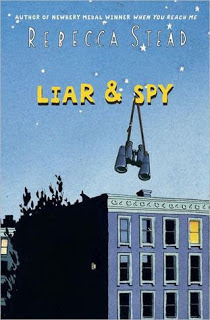
Read it! But don't say I didn't warn you.

Her newest is the much-acclaimed Liar and Spy.

Read it! But don't say I didn't warn you.
Published on November 02, 2012 07:00
November 1, 2012
Thursday's Thought
Nothing is impossible. The word itself says, "I'm possible!"
Audrey Hepburn
Audrey Hepburn
Published on November 01, 2012 07:30
October 30, 2012
Teacher Tuesday
May I just say how much fun I'm having "meeting" amazing teachers and librarians from all over the country? I'm very delighted today to introduce you to Laura Given, a librarian at Parkview Center School in Roseville, Minnesota, which she describes as a "first-ring suburb just north of St. Paul." Her library serves students from kindergarten through eighth grade. I am in awe of Laura because she has taken her passion for children's books to a whole new level of commitment. She noticed that her home state did not have a young readers' choice picture book award. And Laura is a can-do kind of person. Start a new state award? No problem! You might want to pour an energy drink to sip while you find out what Laura's been up to.
But first, a little peek into her past!
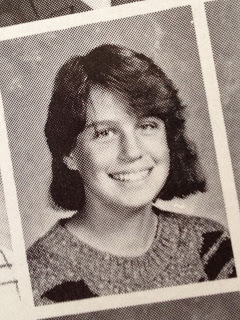 Seventh grade Laura eager to take on the world!
Seventh grade Laura eager to take on the world!
Favorite school lunch as a kid: Hot Turkey with Mashed Potatoes and Gravy Best friend in grade school: Tena W. - She lived kitty-corner (or catty-corner) from me. Times you were the new kid in school: Only once in first grade. I went to a Montessori school for Kindergarten and switched to my neighborhood school in first grade. Teacher who inspired you to stretch: My 8th grade English teacher. She had a writing group that met on Friday’s before school in the library. The one thing you always wished you could do in grade school but never achieved: Climb the rope in gym class.
Now let's get to the heart of this interview. Laura, you shared with me that you are trying to create a young readers picture book choice award in your state.
You crazy girl! What on earth prompted you to take on such a huge project?
I’m not sure I understood what a huge undertaking it would be at first, but it has definitely been a fun process so far.
Tell us what you've done to get the ball rolling:
First of all, I asked around to see if I could join in on someone else’s lead. But there were no takers. That’s when I knew that if I wanted to see this become a reality, I would need to step up and lead myself.
After that realization, I did a lot of research. I wanted to find out what everyone else was doing. Cynthia Leitich Smith’s website was a huge help because part of her site is devoted to State Awards for Children’s and Young Adult Books. I used that as a spring board to find as many state student choice book awards as I could. I looked at their guidelines for selection, currency of nominated titles, number of nominated titles, requirements for student participation. I made a gigantic spreadsheet and took notes on the fabulous ideas that I wanted to somehow incorporate into the new MN award.
You initiated a “pilot” project, featuring 15 picture books* for students to commonly read and vote on. How did you hit upon this step?
I was very excited and motivated to get started on this new Minnesota picture book award idea, but it became apparent that this was going to be a slow process. At one point I was discouraged and thought that an “official” award might not happen for a very long time. I had too much energy and excitement around the idea to wait that long. That’s how my pilot award 15 Books came along.
I took all the research and ideas I had up to that point and put it out there for anyone to join me. My colleague and good friend Anna Zbacnik (@a_to_z_library) of A to Z Library Lady joined in, and we had a lot of fun with the pilot.
Describe the steps you’ve taken to implement this project to date. Please be as detailed as possible, in case some other insane, I mean, incredible librarian wants to follow your lead. (just teasing!)
First I contacted the board of Minnesota Youth Reading Awards (MYRA), the organization that runs the Maud Hart Lovelace Award (the Minnesota student choice award for grades 3-8).
Then, as I mentioned earlier, I researched all the state awards I could and ended up starting my pilot award.
While I was finishing the first year of the the pilot award, MYRA decided the organization was ready to move forward with the idea of introducing a new award.
What followed was a complicated process behind the scenes involving bylaws and Robert’s Rules of Order. Eventually I was voted onto the MYRA board as the chair of the new picture book award, and then the real fun began: reading lots of picture books and finding other picture book lovers to join me.
We now have a group of picture book lovers from around the state reading picture books to help determine what 10 books will be the first nominees to be announced April 25, 2013.
How did you come up with the name for the award?
We wanted the name to be “Minnesotan”, but we also wanted it to not sound too cheesy. So the Hotdish Award, and the Skeeter Award, as well as the Loon Award were all veto-ed. Minnesota’s State Motto is "L'Etoile du Nord", which means “The Star of the North.”
I like thinking of the nominated books as the stars.
What are the next steps?
Star of the North readers are reading picture books and will be sending recommendations on to our selection committee in early 2013. The selection committee will look at the top titles and determine the final list of 10 nominees. Those nominees are kept in a locked vault until April 25, 2013, the date they'll be announced to the public.
After the announcement, students have until March 2014 to read or have read to them 8 of the 10 nominees to be eligible to vote. Student votes are collected in March of 2014, and on April 25, 2014 the first Winner of the Star of the North award will be announced, along with 10 new nominated titles for 2014-15.
(note from Kirby: this gives me chills! So thrilling!)
What are the criteria for this award?
The following limitations are set on the nominated titles:
All titles are classified as Picture Books (they may be fiction or nonfiction).Titles’ copyrights are from previous 2 years (nominees announced in 2013 will have copyrights from 2012 or 2011).Titles are in print and available to order.List of nominees reflects variety in perspectives and genres.Consideration made for Minnesota connections and MN Authors or Illustrators.Caldecott Award winning titles will not be considered.Titles will be reviewed by at least one professional review source. If a title is part of a series, it will only be considered if it is able to stand alone without relying on familiarity with the other titles in the series.Books based on movies or television shows are not eligible for nominations unless the book preceded the movie or television production. Titles may not be a holiday book, a toy, a puzzle, a pop up book or formula fiction.Nominated authors and illustrators must be alive at the time of nomination and living in North America.The previous year’s WINNING author and illustrator are not eligible to have a nominated title for the following year.Only one title per author or illustrator is allowed in the list of nominees.Titles will be chosen with an audience of 5-8 year-olds in mind.Titles are quality, engaging picture books.
How did you arrive at these criteria?
It was a long process. Ultimately we wanted to make sure we were creating a list of books each year that libraries, schools, families and kids would embrace as a quality, engaging list.
I know why young readers choice awards are important to authors/illustrators – they’re an amazing affirmation of our work by the very audience of readers we’re working for. But why are state young readers choice awards important to schools and libraries? And, perhaps most importantly, why are they important for kids?
Student choice awards help create a reading community. Participating in the reading and voting allows students to feel connected to other readers around them, as well as be a part of something larger than their class and their school. Awards and recommended lists are great ways to find quality reading choices - we often teach this to students. There are not many awards where kids feel a part of the award process and have their opinion heard. State awards are a place where that can happen.
What has been the most surprising thing that’s happened to you since diving into this project?
With my pilot picture book award, students and I read the books out loud together. This created an amazing shared reading experience with my primary grades. The excitement and “book bonding” that happened was more powerful that I could have imagined.
I have also been blown away by the support and excitement from teachers, librarians, and book lovers around the state. It is an amazing feeling to be a part of this award from the very beginning.
How could your fellow Minnesotans lend a hand with the Star of the North Award?
Become a member of the Minnesota Youth Reading Awards. For the low price of $10 a year, you can support the award and help students be a part of the voting process.
Also if you love reading picture books, consider becoming a reader for the Star of the North. We would love your input and help.
What else would you like to say about the Star of the North Award and its inception?
One thing I am thrilled is part of the Star of the North Award is the idea that picture books are for everyone. Even though the nominated titles for the award are chosen with 5-8 year-olds in mind, students up through 8th grade are allowed and encouraged to read and vote.
Thank you, thank you, thank you, Laura, for sharing all this great information! You are an inspiration and I imagine that everyone who reads this interview will feel a little like an auntie when the first Star of the North awards are announced!
Follow Laura on Twitter, @LibLaura5, or check out her blog!
* Full disclosure: one of the books that I have co-written with Mary Nethery is on this list but I was unaware of that fact when I invited Laura to be interviewed. Scout's Honor!
But first, a little peek into her past!
 Seventh grade Laura eager to take on the world!
Seventh grade Laura eager to take on the world!Favorite school lunch as a kid: Hot Turkey with Mashed Potatoes and Gravy Best friend in grade school: Tena W. - She lived kitty-corner (or catty-corner) from me. Times you were the new kid in school: Only once in first grade. I went to a Montessori school for Kindergarten and switched to my neighborhood school in first grade. Teacher who inspired you to stretch: My 8th grade English teacher. She had a writing group that met on Friday’s before school in the library. The one thing you always wished you could do in grade school but never achieved: Climb the rope in gym class.
Now let's get to the heart of this interview. Laura, you shared with me that you are trying to create a young readers picture book choice award in your state.
You crazy girl! What on earth prompted you to take on such a huge project?
I’m not sure I understood what a huge undertaking it would be at first, but it has definitely been a fun process so far.
Tell us what you've done to get the ball rolling:
First of all, I asked around to see if I could join in on someone else’s lead. But there were no takers. That’s when I knew that if I wanted to see this become a reality, I would need to step up and lead myself.
After that realization, I did a lot of research. I wanted to find out what everyone else was doing. Cynthia Leitich Smith’s website was a huge help because part of her site is devoted to State Awards for Children’s and Young Adult Books. I used that as a spring board to find as many state student choice book awards as I could. I looked at their guidelines for selection, currency of nominated titles, number of nominated titles, requirements for student participation. I made a gigantic spreadsheet and took notes on the fabulous ideas that I wanted to somehow incorporate into the new MN award.
You initiated a “pilot” project, featuring 15 picture books* for students to commonly read and vote on. How did you hit upon this step?
I was very excited and motivated to get started on this new Minnesota picture book award idea, but it became apparent that this was going to be a slow process. At one point I was discouraged and thought that an “official” award might not happen for a very long time. I had too much energy and excitement around the idea to wait that long. That’s how my pilot award 15 Books came along.
I took all the research and ideas I had up to that point and put it out there for anyone to join me. My colleague and good friend Anna Zbacnik (@a_to_z_library) of A to Z Library Lady joined in, and we had a lot of fun with the pilot.
Describe the steps you’ve taken to implement this project to date. Please be as detailed as possible, in case some other insane, I mean, incredible librarian wants to follow your lead. (just teasing!)
First I contacted the board of Minnesota Youth Reading Awards (MYRA), the organization that runs the Maud Hart Lovelace Award (the Minnesota student choice award for grades 3-8).
Then, as I mentioned earlier, I researched all the state awards I could and ended up starting my pilot award.
While I was finishing the first year of the the pilot award, MYRA decided the organization was ready to move forward with the idea of introducing a new award.
What followed was a complicated process behind the scenes involving bylaws and Robert’s Rules of Order. Eventually I was voted onto the MYRA board as the chair of the new picture book award, and then the real fun began: reading lots of picture books and finding other picture book lovers to join me.
We now have a group of picture book lovers from around the state reading picture books to help determine what 10 books will be the first nominees to be announced April 25, 2013.
How did you come up with the name for the award?
We wanted the name to be “Minnesotan”, but we also wanted it to not sound too cheesy. So the Hotdish Award, and the Skeeter Award, as well as the Loon Award were all veto-ed. Minnesota’s State Motto is "L'Etoile du Nord", which means “The Star of the North.”
I like thinking of the nominated books as the stars.
What are the next steps?
Star of the North readers are reading picture books and will be sending recommendations on to our selection committee in early 2013. The selection committee will look at the top titles and determine the final list of 10 nominees. Those nominees are kept in a locked vault until April 25, 2013, the date they'll be announced to the public.
After the announcement, students have until March 2014 to read or have read to them 8 of the 10 nominees to be eligible to vote. Student votes are collected in March of 2014, and on April 25, 2014 the first Winner of the Star of the North award will be announced, along with 10 new nominated titles for 2014-15.
(note from Kirby: this gives me chills! So thrilling!)
What are the criteria for this award?
The following limitations are set on the nominated titles:
All titles are classified as Picture Books (they may be fiction or nonfiction).Titles’ copyrights are from previous 2 years (nominees announced in 2013 will have copyrights from 2012 or 2011).Titles are in print and available to order.List of nominees reflects variety in perspectives and genres.Consideration made for Minnesota connections and MN Authors or Illustrators.Caldecott Award winning titles will not be considered.Titles will be reviewed by at least one professional review source. If a title is part of a series, it will only be considered if it is able to stand alone without relying on familiarity with the other titles in the series.Books based on movies or television shows are not eligible for nominations unless the book preceded the movie or television production. Titles may not be a holiday book, a toy, a puzzle, a pop up book or formula fiction.Nominated authors and illustrators must be alive at the time of nomination and living in North America.The previous year’s WINNING author and illustrator are not eligible to have a nominated title for the following year.Only one title per author or illustrator is allowed in the list of nominees.Titles will be chosen with an audience of 5-8 year-olds in mind.Titles are quality, engaging picture books.
How did you arrive at these criteria?
It was a long process. Ultimately we wanted to make sure we were creating a list of books each year that libraries, schools, families and kids would embrace as a quality, engaging list.
I know why young readers choice awards are important to authors/illustrators – they’re an amazing affirmation of our work by the very audience of readers we’re working for. But why are state young readers choice awards important to schools and libraries? And, perhaps most importantly, why are they important for kids?
Student choice awards help create a reading community. Participating in the reading and voting allows students to feel connected to other readers around them, as well as be a part of something larger than their class and their school. Awards and recommended lists are great ways to find quality reading choices - we often teach this to students. There are not many awards where kids feel a part of the award process and have their opinion heard. State awards are a place where that can happen.
What has been the most surprising thing that’s happened to you since diving into this project?
With my pilot picture book award, students and I read the books out loud together. This created an amazing shared reading experience with my primary grades. The excitement and “book bonding” that happened was more powerful that I could have imagined.
I have also been blown away by the support and excitement from teachers, librarians, and book lovers around the state. It is an amazing feeling to be a part of this award from the very beginning.
How could your fellow Minnesotans lend a hand with the Star of the North Award?
Become a member of the Minnesota Youth Reading Awards. For the low price of $10 a year, you can support the award and help students be a part of the voting process.
Also if you love reading picture books, consider becoming a reader for the Star of the North. We would love your input and help.
What else would you like to say about the Star of the North Award and its inception?
One thing I am thrilled is part of the Star of the North Award is the idea that picture books are for everyone. Even though the nominated titles for the award are chosen with 5-8 year-olds in mind, students up through 8th grade are allowed and encouraged to read and vote.
Thank you, thank you, thank you, Laura, for sharing all this great information! You are an inspiration and I imagine that everyone who reads this interview will feel a little like an auntie when the first Star of the North awards are announced!
Follow Laura on Twitter, @LibLaura5, or check out her blog!
* Full disclosure: one of the books that I have co-written with Mary Nethery is on this list but I was unaware of that fact when I invited Laura to be interviewed. Scout's Honor!
Published on October 30, 2012 07:00
October 26, 2012
Friend Friday
I first met Terry Trueman at a Children's Literature Festival in Warrensburg, Missouri. Terry is one of those larger-than-life kind of people and I am not. So our first meeting would not have led me to believe we could become friends. But Terry's heart is huge and we have shared many encouraging (and discouraged!) emails back and forth. Though it's been out since August, I'm pleased to celebrate his latest book, Life Happens Next.
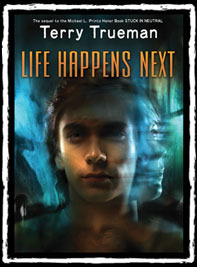
Here are the official details:
Stuck in Neutral, a Printz Honor Book, introduced the world to Shawn McDaniel, a fourteen-year-old kid with cerebral palsy. But what happens next?
Shawn's got a new perspective on life. But no one has a clue. That's because they can see only his wheelchair, his limp body, his drool. What they don't see? His brain, with perfect auditory memory. And his heart, which is in love with a girl. And his fierce belief that someday someone will realize there's way more to him than his appearance.
How do you connect with others when you can't talk, walk, or even wave hello? In the sequel to Stuck in Neutral, which ALA Booklist called "an intense reading experience," Shawn McDaniel discovers a new definition of "normal" and finds that life happens next for everyone.
Before you read the book, be sure to hop on over to Terry's energetic and engaging website.

Here are the official details:
Stuck in Neutral, a Printz Honor Book, introduced the world to Shawn McDaniel, a fourteen-year-old kid with cerebral palsy. But what happens next?
Shawn's got a new perspective on life. But no one has a clue. That's because they can see only his wheelchair, his limp body, his drool. What they don't see? His brain, with perfect auditory memory. And his heart, which is in love with a girl. And his fierce belief that someday someone will realize there's way more to him than his appearance.
How do you connect with others when you can't talk, walk, or even wave hello? In the sequel to Stuck in Neutral, which ALA Booklist called "an intense reading experience," Shawn McDaniel discovers a new definition of "normal" and finds that life happens next for everyone.
Before you read the book, be sure to hop on over to Terry's energetic and engaging website.
Published on October 26, 2012 07:30
October 25, 2012
Thursday's Thought
Winning can be defined as the science of being totally prepared.
George Allen
George Allen
Published on October 25, 2012 07:30
October 23, 2012
Teacher Tuesday
I'm delighted to introduce you to Brian Wilhorn, from Vesper Community Academy in Vesper, Wisconsin. I don't know quite how he does it, but Brian is the reading teacher AND the lead teacher for the 4-year-old kindergarteners through the sixth graders. That's a large age span and set of differences. I am in awe of this guy. And you will be, too, after you read the interview below.
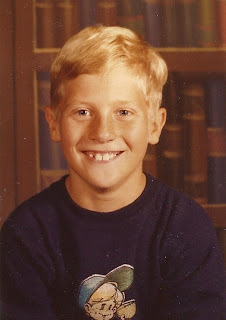 Brian in 4th grade-- note the books in the background. A sign of things to come!
Brian in 4th grade-- note the books in the background. A sign of things to come!
Brian, let's take a little peek at your past:
Favorite school lunch as a kid: A tie between the chicken gravy over biscuits and Salisbury steak.Best friend in grade school: It changed year to year. (I think teachers tried spreading us out between classrooms.) I met Jeff W. in ninth grade and we’re good friends to this day.Times you were the new kid in school: Always attending the neighborhood school kept me from ever really being the new kid until college, but I was probably the most out-of-place-kid in junior high shop class.Teacher who inspired you to stretch: The professor in my college freshman writing class, whose name I’ve unfortunately forgotten. She taught me that writing is more than good grammar and following directions. She told me my biography was boring. She was right. I completely rewrote it.The one thing you always wished you could do in grade school but never achieved: Color inside the lines and have fancy, neat handwriting.Brian, you shared with me that one of your big passions is providing context for your students. This resonated with me because, as a writer, I sometimes assume readers know things that they don't, necessarily. For example, when I began talking to students about Hattie Big Sky, I quickly realized I needed to explain what "homesteading" was. I've been so impressed by the ways in which you use blogs to
enrich your readers' understanding of the books they’re reading. How did your blogs come about?
Help Readers Love Reading came about as an extension of my reading presentations. The biggest request I receive from teachers is for more books, so I created the blog as an answer to that request.
The MrWReads blog started as a way to quickly give students links, videos, resources, and directions for lessons. Then the reading part slowly took over as I started adding visual resources for my class read alouds.
Why do you do it?
I started Googling things for myself from the books I’d read before I started sharing with students. When reading Alvin Ho by Lenore Look, I Googled Johnny Astro on a whim and was thrilled to discover it was a real toy and that the commercial was on YouTube. Then I found a site that created Shakespearian curses, just like Alvin’s dad. (Thou grizzled, lily-livered giglet!) In many cases the online resources come from my own searches. I’ll look something up, find it fascinating, and think, “Hey! My students should see this!”
I don’t create online resources for all the books we use. The resources come about when I feel we can really dig into a book as a class.
Do you have students help you in this process? If so, how?
Not directly, but now that you mention it, that could be a great way to combine self-chosen reading, research, and writing. For the posts I’ve done, I just try to imagine what my students might not have locked away in their background knowledge and create posts to share that information.
What has most surprised you since you began blogging about books and reading?
By far the biggest surprise has been the response to my posts (here and here) on Wonder by R. J. Palacio. I started writing them to use with my students shortly after the book’s release, but as Wonder’s audience has grown, so has the interest in the online resources. Those posts have generated around 9,000 page views in September, 2012. By comparison, in September, 2010 the entire MrWReads blog generated 58 views.
What are the biggest impacts you’ve seen on your students?
I’ll be the first to admit that these online resources are not necessary for readers. Great books work their magic with readers on their own. But I think the visual resources can help readers more clearly see the story in their imaginations. Our rural community doesn’t have crosstown buses or a subway. Our acres of cornfields are pretty far removed from the Florida Keys.
The biggest impacts have come from historical resources. Learning that the church bombing in The Watsons Go to Birmingham - 1963 actually happened added to the seriousness of the story’s events (see the post here). Students realized that Kenny’s sister, Joey, really could have died that Sunday morning. Reading newspaper reports about the 1935 Labor Day hurricane in the Florida Keys helped students understand how incredible it was that Turtle and her cousins survived on the pirate’s key in Turtle in Paradise (read that post here). In Wonder, when students said that touching Auggie gave you the plague, learning what the plague actually did helped students realize how hurtful Auggie’s classmates’ words were, even if they didn’t realize what they were saying (here is that post).
These posts of yours seem like a ton of work. Why is it worth the effort? Would you encourage other teachers to try something like this?
They can be a lot of work, but I get lost in the research and enjoy fleshing out my own understanding of the story. Sometimes it’s like I’m tracking down the author’s own research.
Any time that teachers spend learning more about their subject matter is time well spent. When students say, “I didn’t know...” or “Did he really...” or “I can’t believe...”, then I’m always glad I took the time to share whatever it was they didn’t know.
What resources have been particularly helpful to you in generating these blog posts?
Mostly a combination of my own curiosity, my students’ knowledge, and Google.
What practical tips do you have for other teachers who might want to launch an effort like this?
Try to keep posts from becoming some sort of assigned reading. Don’t let learning kill the enjoyment of the story. Try to use natural breaks in the story to quickly share images, but don’t let the story get fragmented.
Also, start by seeing what is already out there. When I started the Wonder posts, I didn’t know that author R. J. Palacio already had similar resources on her own site. That would have been a great place for me to start.
How could authors and/or publishers help you in your efforts to provide context for your students?
Authors and publishers are so easy to connect with today. Sometimes you just need to ask. When creating the Wonder resources, I tweeted R. J. Palacio asking if the Avatar Miranda mentions was the cartoon TV series or the James Cameron movie. A few hours later she tweeted the answer. (It was the cartoon.)
Brian, thank you so much for taking time to share these insights. I'm sure there are many teachers out there who are going to give this a try! And as a passionate researcher myself, you've given me incentive (and permission!) to make my Author's Notes and webpages more informative.
 Brian in 4th grade-- note the books in the background. A sign of things to come!
Brian in 4th grade-- note the books in the background. A sign of things to come!Brian, let's take a little peek at your past:
Favorite school lunch as a kid: A tie between the chicken gravy over biscuits and Salisbury steak.Best friend in grade school: It changed year to year. (I think teachers tried spreading us out between classrooms.) I met Jeff W. in ninth grade and we’re good friends to this day.Times you were the new kid in school: Always attending the neighborhood school kept me from ever really being the new kid until college, but I was probably the most out-of-place-kid in junior high shop class.Teacher who inspired you to stretch: The professor in my college freshman writing class, whose name I’ve unfortunately forgotten. She taught me that writing is more than good grammar and following directions. She told me my biography was boring. She was right. I completely rewrote it.The one thing you always wished you could do in grade school but never achieved: Color inside the lines and have fancy, neat handwriting.Brian, you shared with me that one of your big passions is providing context for your students. This resonated with me because, as a writer, I sometimes assume readers know things that they don't, necessarily. For example, when I began talking to students about Hattie Big Sky, I quickly realized I needed to explain what "homesteading" was. I've been so impressed by the ways in which you use blogs to
enrich your readers' understanding of the books they’re reading. How did your blogs come about?
Help Readers Love Reading came about as an extension of my reading presentations. The biggest request I receive from teachers is for more books, so I created the blog as an answer to that request.
The MrWReads blog started as a way to quickly give students links, videos, resources, and directions for lessons. Then the reading part slowly took over as I started adding visual resources for my class read alouds.
Why do you do it?
I started Googling things for myself from the books I’d read before I started sharing with students. When reading Alvin Ho by Lenore Look, I Googled Johnny Astro on a whim and was thrilled to discover it was a real toy and that the commercial was on YouTube. Then I found a site that created Shakespearian curses, just like Alvin’s dad. (Thou grizzled, lily-livered giglet!) In many cases the online resources come from my own searches. I’ll look something up, find it fascinating, and think, “Hey! My students should see this!”
I don’t create online resources for all the books we use. The resources come about when I feel we can really dig into a book as a class.
Do you have students help you in this process? If so, how?
Not directly, but now that you mention it, that could be a great way to combine self-chosen reading, research, and writing. For the posts I’ve done, I just try to imagine what my students might not have locked away in their background knowledge and create posts to share that information.
What has most surprised you since you began blogging about books and reading?
By far the biggest surprise has been the response to my posts (here and here) on Wonder by R. J. Palacio. I started writing them to use with my students shortly after the book’s release, but as Wonder’s audience has grown, so has the interest in the online resources. Those posts have generated around 9,000 page views in September, 2012. By comparison, in September, 2010 the entire MrWReads blog generated 58 views.
What are the biggest impacts you’ve seen on your students?
I’ll be the first to admit that these online resources are not necessary for readers. Great books work their magic with readers on their own. But I think the visual resources can help readers more clearly see the story in their imaginations. Our rural community doesn’t have crosstown buses or a subway. Our acres of cornfields are pretty far removed from the Florida Keys.
The biggest impacts have come from historical resources. Learning that the church bombing in The Watsons Go to Birmingham - 1963 actually happened added to the seriousness of the story’s events (see the post here). Students realized that Kenny’s sister, Joey, really could have died that Sunday morning. Reading newspaper reports about the 1935 Labor Day hurricane in the Florida Keys helped students understand how incredible it was that Turtle and her cousins survived on the pirate’s key in Turtle in Paradise (read that post here). In Wonder, when students said that touching Auggie gave you the plague, learning what the plague actually did helped students realize how hurtful Auggie’s classmates’ words were, even if they didn’t realize what they were saying (here is that post).
These posts of yours seem like a ton of work. Why is it worth the effort? Would you encourage other teachers to try something like this?
They can be a lot of work, but I get lost in the research and enjoy fleshing out my own understanding of the story. Sometimes it’s like I’m tracking down the author’s own research.
Any time that teachers spend learning more about their subject matter is time well spent. When students say, “I didn’t know...” or “Did he really...” or “I can’t believe...”, then I’m always glad I took the time to share whatever it was they didn’t know.
What resources have been particularly helpful to you in generating these blog posts?
Mostly a combination of my own curiosity, my students’ knowledge, and Google.
What practical tips do you have for other teachers who might want to launch an effort like this?
Try to keep posts from becoming some sort of assigned reading. Don’t let learning kill the enjoyment of the story. Try to use natural breaks in the story to quickly share images, but don’t let the story get fragmented.
Also, start by seeing what is already out there. When I started the Wonder posts, I didn’t know that author R. J. Palacio already had similar resources on her own site. That would have been a great place for me to start.
How could authors and/or publishers help you in your efforts to provide context for your students?
Authors and publishers are so easy to connect with today. Sometimes you just need to ask. When creating the Wonder resources, I tweeted R. J. Palacio asking if the Avatar Miranda mentions was the cartoon TV series or the James Cameron movie. A few hours later she tweeted the answer. (It was the cartoon.)
Brian, thank you so much for taking time to share these insights. I'm sure there are many teachers out there who are going to give this a try! And as a passionate researcher myself, you've given me incentive (and permission!) to make my Author's Notes and webpages more informative.
Published on October 23, 2012 07:30
October 19, 2012
Friend Friday
I've been a fan of Frances O'Roark Dowell since I read her Chicken Boy. In nearly every book she writes, she takes us into the life of a little kid dealing with big stuff. Her work is honest, true and brimming with heart.
Still on my to-read pile is her newest, The Second Life of Abigail Walker .
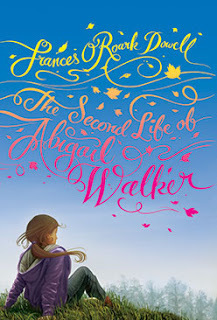 After reading this review by Kirkus, I cannot wait to crack open that beautiful cover:
After reading this review by Kirkus, I cannot wait to crack open that beautiful cover:
When Abby’s one-time friend whispers to her, “You’re dead,” Abby knows it’s true. Maybe not dead physically, but dying inside. Avoiding Georgia and Kristen, who make snarky remarks about her weight in the lunchroom, the sixth-grader makes new friends, including two Indian-American boys whose easy tolerance is refreshing. . . As she did in The Secret Language of Girls (2004) and its sequel, The Kind of Friends We Used to Be (2009), Dowell weaves themes of friendship and personal growth into a rich and complex narrative. . . Middle school mean girls are not uncommon, in fiction or in life, but seldom has an author so successfully defeated them without leaving her protagonist or her reader feeling a little bit mean herself. (Kirkus)
Congratulations, Frances!
Still on my to-read pile is her newest, The Second Life of Abigail Walker .
 After reading this review by Kirkus, I cannot wait to crack open that beautiful cover:
After reading this review by Kirkus, I cannot wait to crack open that beautiful cover:When Abby’s one-time friend whispers to her, “You’re dead,” Abby knows it’s true. Maybe not dead physically, but dying inside. Avoiding Georgia and Kristen, who make snarky remarks about her weight in the lunchroom, the sixth-grader makes new friends, including two Indian-American boys whose easy tolerance is refreshing. . . As she did in The Secret Language of Girls (2004) and its sequel, The Kind of Friends We Used to Be (2009), Dowell weaves themes of friendship and personal growth into a rich and complex narrative. . . Middle school mean girls are not uncommon, in fiction or in life, but seldom has an author so successfully defeated them without leaving her protagonist or her reader feeling a little bit mean herself. (Kirkus)
Congratulations, Frances!
Published on October 19, 2012 07:30



